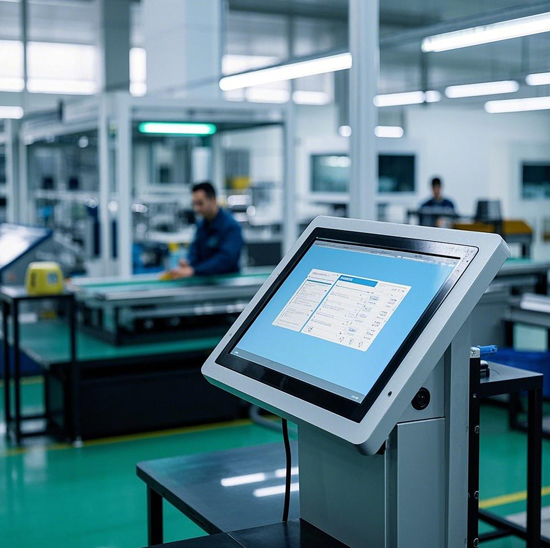For mid-size plants, where every piece of equipment directly impacts production schedules and operational costs, the Industrial Touch Display is more than just a control interface—it’s a critical link in monitoring workflows, managing machinery, and ensuring smooth operations. A malfunctioning display can lead to delays, errors in data reading, and even unplanned downtime, which mid-size facilities can ill afford due to tighter resource margins. Ainda, many plants overlook proactive maintenance, treating issues only when they arise. This guide will walk you through daily care routines, common troubleshooting steps, and long-term maintenance strategies tailored to mid-size plants, helping you keep your Industrial Touch Displays in optimal condition.

Daily Maintenance Routines for Industrial Touch Displays
Consistent daily care is the foundation of keeping Industrial Touch Displays functioning reliably. These simple steps take minimal time but significantly reduce wear and tear:
1. Cleaning the Screen (Avoid Damage While Removing Debris)
Mid-size plant environments often have dust, oil mist, or occasional splatters—all of which can impair touch sensitivity over time. Siga estas etapas:
Use a microfiber cloth (dry or slightly dampened with distilled water) to wipe the screen daily. Avoid paper towels or rough fabrics, which scratch the surface.
For oil or grease stains, apply a small amount of isopropyl alcohol (70% concentration) to the cloth—never spray liquid directly on the display, as it can seep into internal components.
Power off the display before cleaning to prevent accidental inputs and ensure a clearer view of smudges.
2. Checking Connections and Mounting
Vibration from nearby machinery or regular operator contact can loosen cables or mounting brackets. Each day:
Inspect the power and data cables (Por exemplo, USB, Ethernet) to ensure they’re securely plugged in—loose connections cause screen flickering or unresponsive touch.
Tighten any loose screws on the display’s mounting bracket to prevent shifting, which can strain cables over time.
3. Monitoring Operating Conditions
Industrial Touch Displays are sensitive to extreme environments. Make it a habit to:
Check that the ambient temperature around the display stays within its rated range (tipicamente -10 ° C a 60 ° C). Use a thermometer if your plant has fluctuating heat (Por exemplo, near furnaces).
Ensure the display is not exposed to direct sunlight or harsh artificial light, which can cause glare and overheating. Adjust nearby lighting if needed.
Troubleshooting Common Industrial Touch Display Issues
Even with daily care, issues can arise. Mid-size plants need quick fixes to avoid downtime—here’s how to address the most frequent problems:
1. Unresponsive Touch or Erratic Inputs
This is often caused by debris or calibration issues:
First, clean the screen thoroughly (as outlined above) to remove dust or oil that blocks touch sensors.
If problems persist, recalibrate the touch function via the display’s settings menu. Most Industrial Touch Displays have a built-in calibration tool—follow the on-screen prompts to align touch points.
For resistive touch displays, check if the screen has cracks (a common cause of unresponsiveness)—replace the screen if damage is found.
2. Screen Flickering or Dimness
Flickering usually stems from power or connection issues:
Test the power outlet with another device to rule out electrical problems. If the outlet is faulty, use a surge protector to prevent voltage spikes.
Inspect data cables for fraying or bent pins—replace damaged cables immediately (mid-size plants should keep spare cables in stock for quick swaps).
Dimness may indicate a failing backlight. If adjusting brightness settings doesn’t help, contact a technician to replace the backlight before it fails completely.
3. Error Messages or Software Glitches
These often relate to compatibility or software updates:
Note the exact error message (Por exemplo, “Communication Failed”) and check if it corresponds to a recent change (Por exemplo, new machinery integration).
Restart the display and connected devices to resolve temporary glitches.
If errors persist, verify that the display’s firmware is up to date—manufacturers release updates to fix bugs, especially for displays connected to plant management systems.
Long-Term Maintenance Strategies for Mid-Size Plants
To extend the lifespan of Industrial Touch Displays (typically 5–7 years) and align with mid-size plant budgets, adopt these proactive measures:
1. Scheduled Professional Inspections
Twice a year, hire a technician to:
Open the display casing (if allowed by the manufacturer) to clean internal components (dust buildup can cause overheating).
Test touch sensor accuracy with specialized tools and adjust calibration beyond basic user settings.
Check for signs of component wear (Por exemplo, capacitors, wiring) that may lead to future failures.
2. Spare Parts Inventory
Mid-size plants can’t afford long wait times for replacements. Stock essential spares:
Replacement screens (matching your display model) to swap out quickly if damage occurs.
Power adapters and data cables (common failure points).
Screen protectors (to prevent scratches—especially useful in high-traffic workstations).
3. Training Staff on Proper Usage
Many display issues stem from operator error. Train your team to:
Avoid pressing the screen with sharp objects (Por exemplo, screwdrivers) or excessive force.
Report minor issues (Por exemplo, Pisculadores ocasionais) immediately, antes que eles escalem.
Follow cleaning protocols to prevent accidental damage.
FAQs About Industrial Touch Display Maintenance
Q1: How often should we replace an Industrial Touch Display in a mid-size plant?
A1: With proper maintenance, most displays last 5–7 years. Replace sooner if: touch sensitivity degrades beyond repair, the screen develops unrepairable cracks, or the display no longer integrates with updated plant software.
Q2: Can we use household glass cleaner on Industrial Touch Displays?
A2: No—household cleaners contain ammonia or abrasive chemicals that damage the screen’s protective coating. Stick to distilled water or 70% isopropyl alcohol.
Q3: What’s the best way to prevent display damage during plant cleaning (Por exemplo, floor washing)?
A3: Cover the display with a waterproof (rated IP65 or higher) during deep cleaning. Ensure the is removed once cleaning is done to prevent overheating.
4º trimestre: Why does our display work better in the morning but slow down in the afternoon?
A4: This is often due to overheating from afternoon temperature rises in the plant. Ensure the display is in a well-ventilated area, and consider adding a small fan nearby if temperatures exceed 60°C.
Proper maintenance of Industrial Touch Displays is a small investment that yields big returns for mid-size plants—reducing downtime, extending equipment life, and ensuring consistent production workflows. By combining daily care, quick troubleshooting, and long-term strategies, you can keep your displays reliable for years.
If your plant is struggling with frequent display issues (Por exemplo, persistent unresponsiveness, erros recorrentes) or you need help creating a customized maintenance plan, Preencha o formulário em nosso site. Our industrial display experts will assess your plant’s environment, display models, and usage patterns, then provide tailored recommendations—from spare parts lists to technician scheduling—helping you minimize disruptions and maximize your equipment’s value.

